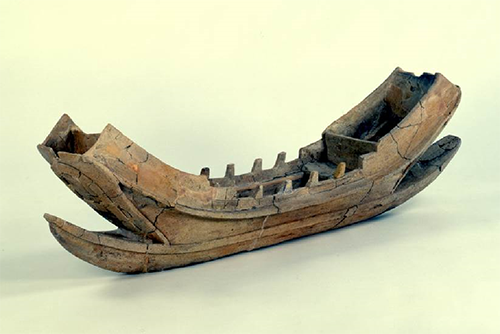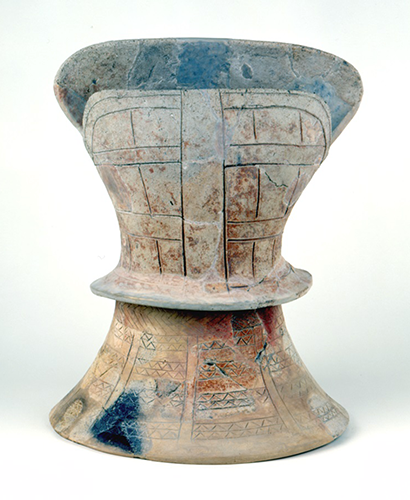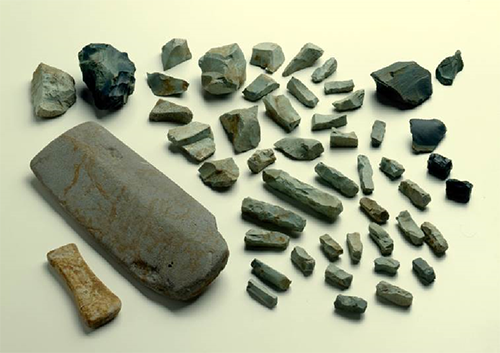
Boat-shaped haniwa
(National Important Cultural Property)
Early middle Kofun period (late 4th century to the end of the 4th century); unearthed from the Nagahara-Takamawari No. 2 burial mound; 128.7 cm long; held by Osaka Museum of History for the Agency for Cultural Affairs

The Nagahara-Takamawari No. 2 burial mound is a circular burial mound with a diameter of 21 meters, where a wide variety of representational haniwa were discovered, including house-, armor-, shield-, quiver-, sunshade- and boat-shaped haniwa. This boat-shaped haniwa was discovered lying at the bottom of a ditch surrounding the burial mound. Considering that most of the fragments of this haniwa were found there, it is thought to have been placed and always remained in the ditch. This haniwa represents a semi-composite boat and looks like a dugout canoe equipped with planks alongside the body, a two-pronged bow and stern, shield-shaped chocks at the front and rear, and a deck and partitions. There are four pairs of oar pivots at the center of both sides of the boat, which indicates this haniwa was modeled after a large boat with more than eight rowers. This is a uniquely designed boat-shaped haniwa uncovered in the Kinki region, and, along with other haniwa unearthed from the Nagahara-Takamawari No. 1 and No. 2 burial mounds, has been designated an National Important Cultural Property.
Cuirass-shaped haniwa and tuille-shaped haniwa
(National Important Cultural Properties)
Early middle Kofun period (late 4th century to the end of the 4th century); unearthed from the Nagahara-Takamawari No. 2 burial mound; 48 cm high; held by Osaka Museum of History for the Agency for Cultural Affairs

A cuirass is a piece of armor for covering the chest and back. This cuirass-shaped haniwa, unearthed from the Nagahara-Takamawari No. 2 burial mound, is a simple representation of a cuirass made of leather-bound rectangular iron plates, with red pigment applied on the surface. It has a short cylindrical pedestal, but considering that the surface of the pedestal is only roughly finished and has no pigment applied on it, this haniwa is thought to have been placed into a tuille-shaped haniwa to stand upright. A tuille is a piece of armor for protecting the waist and made by joining leather belts using straps to make a skirt-like hem. Just like a tuille that typically has a saw-toothed pattern embroidered on it, this haniwa has the same pattern carved on the surface. A total of three pairs of cuirass-shaped and tuille-shaped haniwa were unearthed from the Nagahara-Takamawari No. 1 and No. 2 burial mounds.
Artifacts Associated with Bead-Making
Middle Kofun period (5th century); unearthed from the Nagahara Site; the whetstone (in the lower left) 5 cm long; held by the Osaka City Cultural Properties Association for the Osaka City Board of Education

In the Kofun period, various production activities were conducted in the Nagahara Site, including bead- and pottery-making, blacksmithing and lacquering. From this site, materials and grit whetstones used to make magatama (curved beads) and kudatama (cylindrical beads) were unearthed, which sheds light on the ancient bead-making process and tells us hard, dark-green jasper or soft light-green tuff were used to make beads. These raw stones were first cut into rough pieces, and the pieces were then shaped by fine chipping, and finally polished with a whetstone. Most of the stones discovered in this site were unfinished and had not been polished. These artifacts give us important insights on how beads buried with the dead in burial mounds were made in the 5th century.
